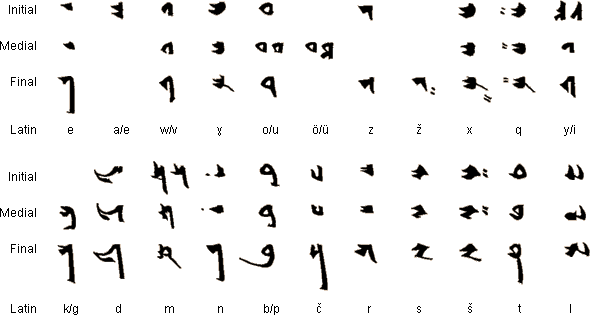Old Uyghur alphabet
| Old Uyghur alphabet | |
|---|---|
| Script type | |
Time period | ca.700s AD – 1800s AD |
| Direction | Horizontal and vertical writing in East Asian scripts, top-to-bottom |
| Languages | Old Uyghur language |
| Related scripts | |
Parent systems | |
Child systems | Mongolian Clear script Manchu |
The Old Uyghur alphabet was used for writing the Old Uyghur language, a variety of Old Turkic spoken in Turfan, which is an ancestor of the modern Yugur language. The term "Old Uyghur" used for this alphabet is misleading because the Uyghurs of Mongolia used the runic Orkhon (Old Turkic) alphabet, and only adopted this script used by the local inhabitants when they migrated into Turfan after 840.[1] It was an adaptation of the Sogdian alphabet, used for texts with Buddhist, Manichaean and Christian content for 700–800 years in Turfan. The last known manuscripts are dated to the 18th century. This was the prototype for the Mongolian and Manchu alphabets.
Like Sogdian writing but to an even greater extent, Old Uyghur writing tended to express with matres lectionis not only the long vowels but also the short ones. In fact, the practice of leaving short vowels unrepresented was almost completely abandoned in Uyghur.[2] Thus, while ultimately deriving from a Semitic abjad, the Uyghur script can be said to have been largely "alphabetized".[3]
Gallery
-
Yuan Dynasty Buddhist inscription written in Old Uyghur on the west wall of the Cloud Platform at Juyongguan
-
Yuan Dynasty Buddhist inscription written in Old Uyghur on the east wall of the Cloud Platform at Juyongguan
See also
References
- ^ Sinor, D. (1998), "Chapter 13 - Language situation and scripts", in Bosworth, C.E. (ed.), History of Civilisations of Central Asia, vol. 4 part II, UNESCO Publishing, p. 333, ISBN 81-208-1596-3
- ^ Clauson, Gerard. 2002. Studies in Turkic and Mongolic linguistics. P.110-111.
- ^ Houston, Stephen D. 2004. The first writing: script invention as history and process. P.59



